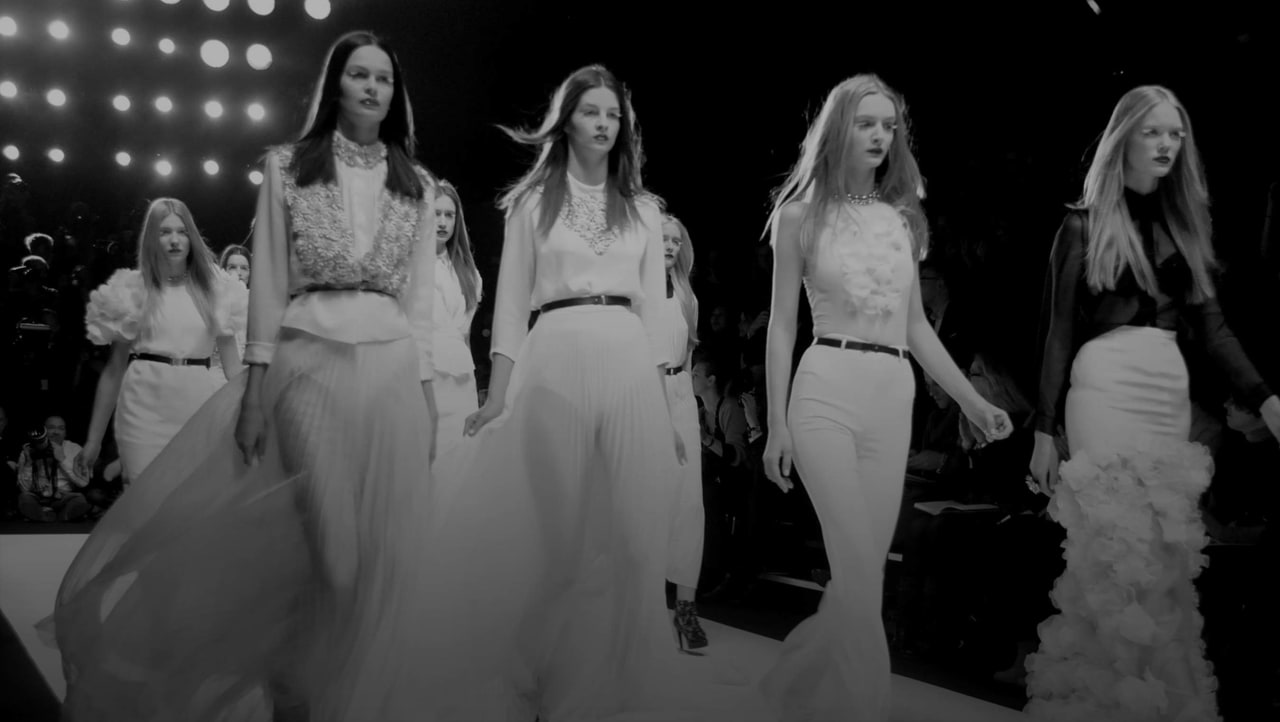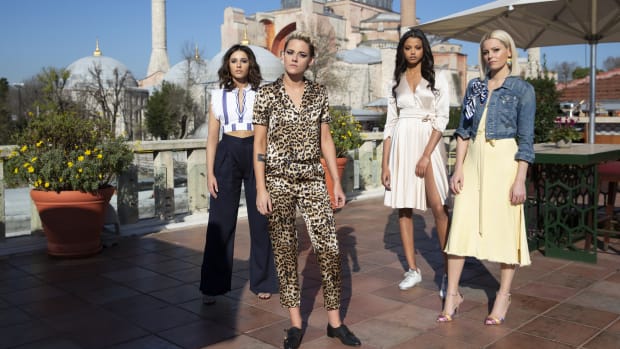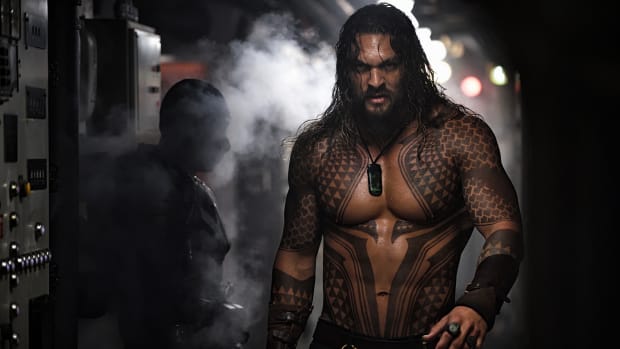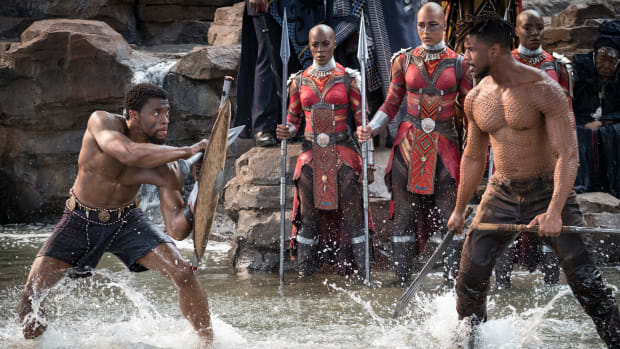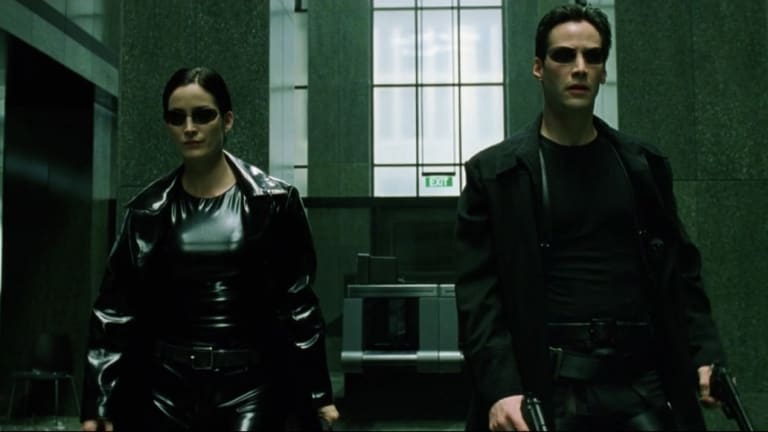
Why the Iconic Costumes in 'The Matrix' Are About So Much More Than 'a Black Shiny Coat'
"The Matrix," which premiered in theaters on March 31, 1999, more than holds up two decades later — and not only because Keanu Reeves is evergreen (and apparently the nicest), Carrie-Anne Moss will forever take names (see: "Jessica Jones") and Laurence Fishburne always commands the screen.
Sure, the sleek black iconic costumes still feel futuristic, more specifically very Fall 2019; probably because the runways and street style were filled with longline leather coats, chunky, lug-sole boots and tiny '90s sunglasses. Granted, "The Matrix" has been continuously influencing designers since John Galliano sent his PVC, micro-glasses and red dress heavy haute couture collection down the runways for Christian Dior Fall 1999, just months after the film hit theaters. But beyond leather trenches and wool dusters, the costumes also help illustrate the movie's boundary-pushing, progressive themes, which stood out from the usual box office fare 20 years ago, and are at the forefront of discussion the fashion industry — and society as a whole — in 2019.
"When we made 'The Matrix,' we were aspiring to what the world could be, which is happening now," says costume designer Kym Barrett ("Aquaman," "Us") about supporting the vision of writers/directors The Wachowskis through costume. (She went on to design the 2003 followup films "The Matrix Reloaded" and "The Matrix Revolutions" and had her two children during the duration of the shoots. "After my daughter was born, the actors came to my home to do their fittings," she remembers.)
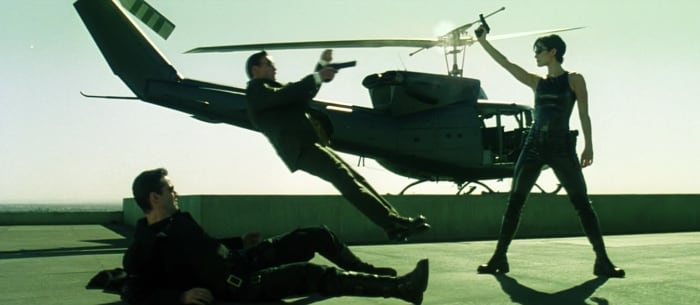
Neo (Keanu Reeves) being saved by Trinity (Carrie-Anne Moss), yet again. Photo: Screengrab/'The Matrix'
The main and supporting cast and characters span a diverse range of ethnicities, cultural backgrounds, genders and ages. The movie opens with a strong, kickass female lead in Moss's Trinity, who repeatedly saves the newbie chosen one Neo (Reeves) while unapologetically expressing her feelings; the overarching threat of AI-powered machines overtaking not just jobs, but the human race still feels cautionary today. (Hey, 80 percent of companies are making investments in AI, Rag & Bone invited a Thom Yorke-voiced AI projection as guest of honor for its Fall 2019 dinner presentation at NYFW and pop-up stores in China are signing customers in with facial scans, just saying...)
So "fashion was the last thing, honestly" on Barrett's mind in 1998 while prepping for the movie. "All I thought was: How can I make these worlds be real and be distinctive?" she explains. "It was all about how to create a language that the audience could clue them into what we were doing subconsciously. So when the story began to reveal itself, it was already embedded in some way in the consciousness."
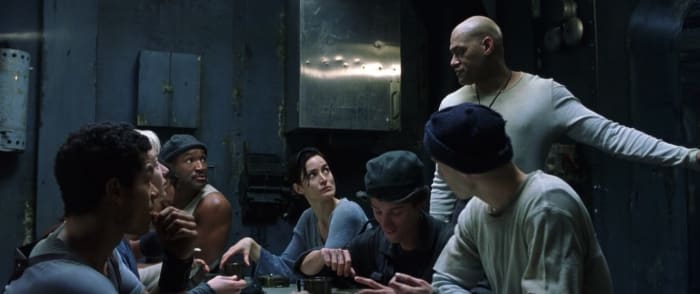
Tank (Marcus Chong), Switch (Belinda McCrory), Dozer (Anthony Ray Parker), Trinity, Mouse (Matt Doran), Morpheus (standing, Laurence Fishburne) and Neo in reality aboard the Nebuchadnezzar hovercraft. The movie featured color codes: blue in reality and green in The Matrix (above). Photo: Screengrab/The Matrix
Barrett used costume to distinguish between the sleek, ultra-stylized virtual simulation within the Matrix cityscapes and the dystopian 21st century "real world" in which the AI-robots harvest the majority of people in pods as batteries. Rebel leader Morpheus (Fishburne) and his group of "grassroots" rebels resist the machines and rescue humans from subjugation. In the non-simulated reality aboard a battered hovercraft, Morpheus, Trinity and the rest of the crew wear blue-washed, faded and distressed layers reflecting sustainability necessitated by their apocalyptic existence (above).
"The real world was a world of recycling," Barrett says. "When somebody dies, their uniform gets washed and goes back in the closet of military clothes [to be repurposed]. Anything they have, they make out of recycled things that they find."
When hacker Thomas Anderson a.k.a. Neo is freed from his pod to join the resistance, Morpheus reveals the truth about The Matrix within "The Construct." The all-white vacant, empty palette of a space — which looks a lot like Janet's void in "The Good Place," by the way — is a virtual "loading site," where humans manifest their "residual self-image" or the "mental projection of your digital self," per Morpheus's explanation. (The idea also sounds eerily similar to the aspirational, filtered and stylized images we humans now present to the universe via Instagram.)

Cypher (Joe Pantoliano), Mouse, Trinity, Morpheus, Switch (Belinda McCrory) and Apoc (Julian Arahanga) in The Matrix. "Fantasy croc," says Barrett, describing the specialty-printed embossing on Morpheus's coat, which was made in both leather and lighter weight fabrics. Photo: Screengrab/The Matrix
Barrett ran with the concept to create the characters' now-iconic and differentiated sleek looks with the duster-length coats and micro-sunglasses (above). "When they go into the Matrix, they create their persona, which is how they see themselves," she explains. "So that was a chance to have a little bit of fun."
In Barrett's mind, Morpheus, Trinity, Neo and co. are the superheroes of the movie, but wasn't going to be so literal. "They can move in an almost gravity-defying way. They can jump across buildings; they can almost fly," she explains, comparing them to the Knights Templar and mythical heroes Ajax and Agamemnon. "I wanted to find a modern version of something that could move like a cape, so that's where the coats were born."
Gifted in programming, hacking and kicking serious ass, Trinity lurks in the shadows as a savior to humans and specifically Neo. Audiences – and a soon to be dispatched male police officer — learn not to underestimate her based on gender ("I think we can handle one little girl.") in her opening scene.
"I wanted her to seem like an oil slick. She's there, but she's not there. She's ever present and she tricks your eye. She's there when you least expect it," explains Barrett about the PVC texture, which also fit into the film's limited budget. Trinity's residual self-image silhouettes run from a short jacket and pants set to an Elizabethan-style long coat-dress to her iconic trench — and she wears functional, rubber-soled boots made for running and fighting. Across the board, Trinity dresses for her task at hand with a practicality that shows respect for her mission, instead of the male gaze.
The practicality for the outfit also served a purpose for Moss's strength and athletic abilities in real life. "Apart from the visual storytelling element, all my actors are doing stunts and they still have to be actually really protected," Barrett explains, about building costumes to allow for wires, harnesses and safety padding, especially since Moss did a bulk of her own stunts.
Recommended Articles
"It's more that than, 'oh, it's a black shiny coat,'" says Barrett, about the enduring allure of Trinity's signature look. "There's a strength in women's clothing [nowadays]. It's a sexy, utilitarian-looking fashion. Fashion is more geared towards a real woman now."
According to "The Matrix" lore, the Wachowski siblings Lana and Lilly, who transitioned in the 2000s, originally wrote the character of Switch as gender fluid: played by a male actor in reality and a female actor in the Matrix. Ultimately, the exploration of gender identity was pared down, possibly due to studio influence, and Switch was played by one actress, Belinda McCrory (below). She dressed in an all-white leather suit in the Matrix to "illuminate" Switch's role as the guard of the crew.
Barrett intentionally designed gender neutral suiting silhouettes for a "subconscious" and not "banging you over the head" aesthetic. "Then people can take from it what they need to complete the jigsaw puzzle," she says. "I never feel like it's my job to teach anyone anything through what people are wearing. I just wanted [McCrory] to look good and feel confident."
To help Neo sartorially channel "The One" in his duster-length wool coat, Barrett looked a mix of cultures and religions around the globe, starting with Japanese Samurai and 18th century Chinese warriors in the vein of "Crouching Tiger, Hidden Dragon." (The Wachowskis hired legendary Hong Kong choreographer and director Yuen Woo-Ping for "The Matrix," which is one of the first Western films to use specialty martial arts wire-work.) Barrett also incorporated influences of "cassocks" worn by clergy leaders in various Western religions.
"I was trying to subconsciously braid a bunch of ancient stories about The One," she says. "It embodies that new strength and resolve, even though he's afraid. The coat gives the audience a visual feeling that Neo has gone from being the confused acolyte into taking on his power. While it doesn't relate to one religion or culture, I wanted it to feel like a special thing you take upon yourself when you are ready to start the quest."
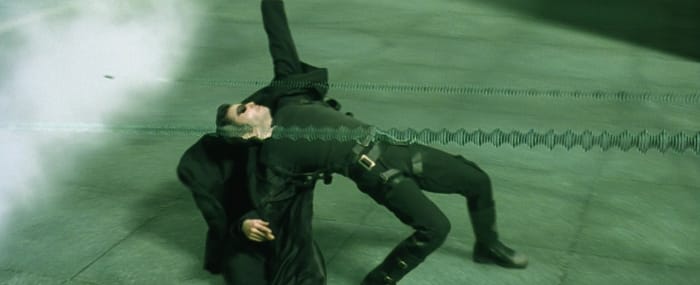
Barrett also says "a lot of really big fans" and the perfect lightweight wool blend helped create the now-iconic billowing effect of Neo's coat in the Bullet Time sequence. Photo: Screengrab/The Matrix
In the famed Bullet Time sequence — which popularized use of the slo-mo, 360-degree filming technique, now utilized each red carpet season by the E! GlamCam — Neo also unveils the full glory of his buckle-up knee-high combat boots. Because of so many foot close-ups, especially in the fight-sequences, shopped footwear was out of the question. "It had to be sole that didn't say, 'Reebok,'" laughs Barrett, who custom-designed all the boots. Secondly and, most importantly, the buckle-feature speaks to sustainability and reuse.
"The concept was: Before you got them, someone else had worn them for a long time," she says, about Neo's presumably inherited buckle-up styles. "The boots had to be adjustable to a certain extent for everybody, which is why there are the adjustable buckles on the side and the toe cap. They had to be utilitarian."
Customization also factored into the tiny sunglasses, both for the storyline and the actual production behind-the-scenes. In the movie, the intention of the sunglasses were to hide the eyes of the people who knew the truth about the Matrix. Since the glasses are worn by each character's aspirational avatar, the shape and style needed to be unique to the wearer, as well.
"They wouldn't create a pair of glasses that could fit on 500 other different people," explains Barrett. "They would create something that only fit on them. Everything was customized" — and not just to the character, but also the actor wearing the glasses IRL.
Barrett commissioned indie designer Richard Walker, whose line Blinde Design was then-sold at high end retailers like Barneys New York, to hand-craft each pair. Since body-scan technology wasn't available then, each actor had to sit through arduous plaster head cast sessions. Walker then built sunglasses, per Barrett's illustrations, to custom-fit each of the actor's measurements and bone structure.
"We only had two or three pairs of each [per actor] because Richard could only work so fast and he hand made them all himself," Barrett says. (Fun fact: He ended up making "The Matrix"-inspired designs when "Reloaded" and "Revolutions" were released in 2003.)
She recalls the producers originally pushing for eyewear from "Sunglass Hut" or the like. But the idea of mass-produced, non-personalized styles didn't fit with "The Matrix" principles and clearly the customized approach to the tiny glasses have stood the test of time — 20 years, specifically. The same could be said for Barrett and her thoughtful costumes, which explored and illustrated the movie's themes and messages, and continue to influence our wardrobes twenty years later.
"[The costumes are] reflecting back more obviously to what's really going on in the world," Barrett says. "So maybe subconsciously, people are connecting to it."
Top and homepage image: Screengrab/The Matrix
Never miss the latest fashion industry news. Sign up for the Fashionista daily newsletter.






